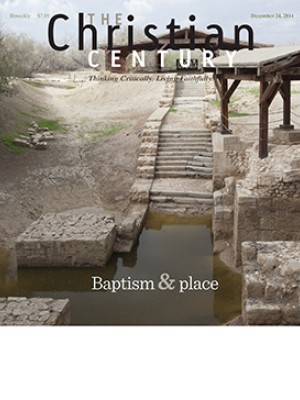After Ferguson, churches push for change
(The Christian Science Monitor) The hand-folded paper peace cranes that adorn the altar and pulpit at Christ the King United Church of Christ in Florissant, Missouri, a mostly black congregation near Ferguson, have been symbols of hope, peace, and solidarity for many churches across the country during times of national crisis.
The origami-like paper cranes came to Christ the King earlier this year from Old South Church in Boston, which had displayed them after the Boston Marathon bombing last year. Before that, the traveling peace symbols hung in the sanctuary of Newtown Congregational, following the shootings at Sandy Hook Elementary in 2012.
Read our latest issue or browse back issues.
Such symbols took on added urgency after the decision of a Missouri grand jury, announced November 24, that it would not indict a Ferguson police officer in the shooting death of black teen Michael Brown.
The case, like that of Trayvon Martin in Florida in 2012 and the police killing of Eric Garner in New York this summer, has laid bare a racial divide that continues to fuel civil unrest.
Brown’s August 9 shooting led to weeks of sometimes violent protests and police counteraction in and around Ferguson, as well as a prolonged and more organized series of protests that at times targeted sporting and cultural events in St. Louis.
After news of the grand jury’s decision spread, people set on fire a retail district in Ferguson, and more than 300 people were arrested in Oakland, California.
In a sermon the day before, Traci Blackmon, pastor of Christ the King, compared the protests in Ferguson to the 1955 Montgomery bus boycott in Alabama that helped usher in the civil rights demonstrations of an earlier generation.
And though she encouraged peaceful protests after the grand jury decision, she told her congregation that its members must continue to stand together for change, according to BBC News.
“The same schools will remain,” Blackmon preached, “the same rates of incarceration will remain, and the same racial profiling will remain.”
In many ways, black churches and other congregations have taken the lead not only as promoters of peace through the crisis but as leaders in a growing effort to mobilize what some have called a new civil rights movement.
“Our congregations are going to be engaging in what we’re calling ‘sacred conversations’ and really talk out what has been happening the past few months,” says Susan Sneed, an organizer with Metropolitan Congregations United in St. Louis, a consortium of local churches devoted to addressing social issues. “We want to really talk about race and racism, and how it has shaped our community, and how we need to reshape our community in different ways, and try to move forward on some long-term plans to make real change that hasn’t been done in the past.”
Some member churches with Metropolitan Congregations United were 24/7 “safe places” for demonstrators. Other churches were open for prayer after the grand jury handed down its decision.
Before a series of protests on Black Friday in shopping centers in the St. Louis area, a group of 100 demonstrators discussed strategy after celebrating Thanksgiving in a church basement, Reuters reported.
On November 29, the NAACP launched its Journey for Justice. Starting from the patch of pavement where Brown was shot and killed, a group of 150 protesters—praying and singing hymns—began a seven-day, 120-mile march to the governor’s mansion in Jefferson City.
Ferguson protests also took place nationwide, as protesters shut down highways as far away as Rhode Island. [Predominantly peaceful protesters took to the streets in several U.S. cities, including Chicago, Dallas, New York, Tucson, and Washington, D.C., according to news reports.]
For some pastors, the unrest unleashed by the shooting of Brown could help rekindle the role of black faith communities as leaders in a long-term effort to effect social changes.
“The church did go to sleep for a while,” said Karen Anderson, pastor of Ward Chapel African Methodist Episcopal Church, another congregation in Florissant, according to Bloomberg. “The church is awakening to the role it can play in helping to bring the community together, helping to educate.” —The Christian Science Monitor






